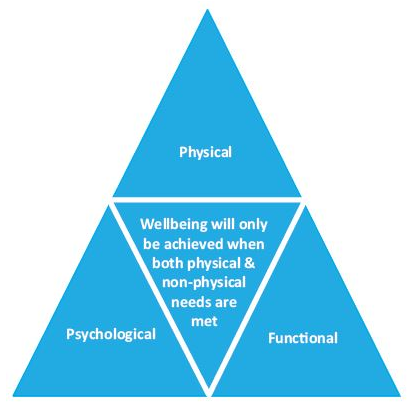Wellbeing and the role of a facility manager
Contents |
[edit] Introduction
To ensure and maintain a ‘well’ workplace, Facility Managers (FMs) can play a vital role. The indoor environment should be a safe place that not only responds to basic human physical needs, but also meets occupants’ psychological needs, enhances their abilities and aids their happiness.
As FMs are trying to optimise energy performance of their buildings, in terms of installed services and building fabric, it is essential for them to also consider how they can help the occupants to better control and spend their human energy.
A ‘well’ workplace is the one that helps the workforce to thrive and happily perform to their optimum ability. To achieve and maintain such an environment, the FMs of a building should formulate a strategy to regularly monitor and evaluate the ‘wellness’ of the building (see Figure 1).
The concept and terminology of wellbeing is not new, however in the last few years we have been witnessing a rapidly-growing interest towards wellbeing. This interest includes understanding and monitoring the factors that can affect occupant wellbeing and productivity in a workplace.
From an organisational management point of view, wellbeing is a major factor in work quality and productivity and, therefore, business success. Poor performing workplaces can affect organisations’ ability to attract and retain the talent they need to succeed. It is, therefore, essential that wellbeing is properly managed in workplaces.
Like anything else, to manage wellbeing in a workplace, it must be measured. This is not an easy task given the intangible nature of wellbeing. It might be argued that assessing wellbeing in a workplace can be tricky and misleading as non-workplace-related life events can also pose threats on individuals’ health.
Although this argument is partly true and sometimes it is impossible to tackle stressful matters at their source, a ‘well’ workplace can act as buffers to the negative effects of those adverse experiences. Existing knowledge also proposes that workplace quality can significantly affect building occupant wellbeing and productivity. In other words, occupant wellbeing can be assessed indirectly by monitoring the different indoor environmental factors of a workplace.
[edit] Physical factors
If building occupants are not physically comfortable they are less likely to be able to concentrate on their tasks and work effectively. This is known as ‘presenteeism’ i.e. when an employee is present at work but cannot perform efficiently. Presenteeism, as well as absenteeism, can cost organisations significantly.
The role of FMs in providing a comfortable indoor environment is broadly recognised. FMs are normally the first point of contact when it comes to issues related to physical comfort as they are usually responsible for managing indoor environmental factors such as:
So, FMs should maintain a physically comfortable environment for the occupants. Providing a platform where the occupants can log/report their wellbeing-related complaints can help the FMs to identify the issues and respond to them faster.
[edit] Functional factors
Another indoor environmental factor that can affect occupant wellbeing is space utilisation. FMs should try to better understand the occupants’ type of work, as well as their company’s strategy and direction to create a space to support the needs.
FMs should collaborate with their HR and ICT teams to ensure their buildings are efficient in terms of occupant density, functionality (fitness for purpose), layout, furniture, ICT, and indoor facilities (e.g. restaurant, shower rooms, meeting rooms with video conferencing facilities, etc.).
In addition to personal workstations, providing designated areas for collaboration, contemplation and formal and informal meetings can significantly contribute towards workplace wellness.
[edit] Psychological factors
Until recently, FMs’ responsibilities were focused on managing HVAC, lighting systems, furniture and other physical factors that affect workplace safety and quality. The FM’s role has now taken on another level. FMs should focus not only on physical factors of buildings but also the psychological experience of people in the workplace.
Many factors in a workplace can influence occupant psychological wellness. Access to nature, for example, is thought to have benefits for wellbeing. Growing evidence suggests that access to nature, outside view and indoor greenery reduces mental fatigue and improves individuals’ ability to deal with stress and other work/life-related issues.
This article was originally published here by BSRIA in March 2017. It was written by Dr. Michelle Agha-Hossein, Sustainable Building Consultant, BSRIA Sustainable Construction Group.
--BSRIA
[edit] Related articles on Designing Buildings Wiki
Featured articles and news
RTPI leader to become new CIOB Chief Executive Officer
Dr Victoria Hills MRTPI, FICE to take over after Caroline Gumble’s departure.
Social and affordable housing, a long term plan for delivery
The “Delivering a Decade of Renewal for Social and Affordable Housing” strategy sets out future path.
A change to adoptive architecture
Effects of global weather warming on architectural detailing, material choice and human interaction.
The proposed publicly owned and backed subsidiary of Homes England, to facilitate new homes.
How big is the problem and what can we do to mitigate the effects?
Overheating guidance and tools for building designers
A number of cool guides to help with the heat.
The UK's Modern Industrial Strategy: A 10 year plan
Previous consultation criticism, current key elements and general support with some persisting reservations.
Building Safety Regulator reforms
New roles, new staff and a new fast track service pave the way for a single construction regulator.
Architectural Technologist CPDs and Communications
CIAT CPD… and how you can do it!
Cooling centres and cool spaces
Managing extreme heat in cities by directing the public to places for heat stress relief and water sources.
Winter gardens: A brief history and warm variations
Extending the season with glass in different forms and terms.
Restoring Great Yarmouth's Winter Gardens
Transforming one of the least sustainable constructions imaginable.
Construction Skills Mission Board launch sector drive
Newly formed government and industry collaboration set strategy for recruiting an additional 100,000 construction workers a year.
New Architects Code comes into effect in September 2025
ARB Architects Code of Conduct and Practice available with ongoing consultation regarding guidance.
Welsh Skills Body (Medr) launches ambitious plan
The new skills body brings together funding and regulation of tertiary education and research for the devolved nation.
Paul Gandy FCIOB announced as next CIOB President
Former Tilbury Douglas CEO takes helm.
UK Infrastructure: A 10 Year Strategy. In brief with reactions
With the National Infrastructure and Service Transformation Authority (NISTA).

























